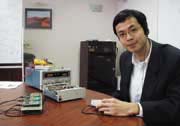
![]()
Researchers at The University of Hong Kong (HKU) have proved that LEDs
(light emitting diodes) can be used to transmit audio signals. A small-scale
prototype appliance built to illustrate capabilities of the technology
to industry and entrepreneurs has an audio transmission range of about
two metres.
![]() But, says
co-investigator Dr Alfred Wong, a range of 30 metres can be achieved with
more powerful LEDs. Possible applications of the technology are varied.
But, says
co-investigator Dr Alfred Wong, a range of 30 metres can be achieved with
more powerful LEDs. Possible applications of the technology are varied.
![]() It could be
used, for example, to transmit traffic reports to motorists when they
stop at traffic lights. Grocery stores could use the technology to broadcast
many individual promotions at different counters for, say, rice, meat
or washing powder. The usual method is to broadcast across the entire
store.
It could be
used, for example, to transmit traffic reports to motorists when they
stop at traffic lights. Grocery stores could use the technology to broadcast
many individual promotions at different counters for, say, rice, meat
or washing powder. The usual method is to broadcast across the entire
store.
| Dr Wong tunes in to music from the LED-based information broadcasting system. |  |
![]() In
a similar application, museums could use the technology to broadcast descriptive
information at individual exhibits, and in any language ordered by the
user. Instead of Juke Box music in, for example, a restaurant, diners
could order their own music from a channel selector at their table. Advantages
of the technology over wired sound systems include:
In
a similar application, museums could use the technology to broadcast descriptive
information at individual exhibits, and in any language ordered by the
user. Instead of Juke Box music in, for example, a restaurant, diners
could order their own music from a channel selector at their table. Advantages
of the technology over wired sound systems include:
![]() The ability
to embed information with lighting which can help save on infrastructure
costs.
The ability
to embed information with lighting which can help save on infrastructure
costs.
![]() As many as 20
channels can be delivered at the same time, the exact number depending
on the degree of sound compression used.
As many as 20
channels can be delivered at the same time, the exact number depending
on the degree of sound compression used.
![]() Because the
audio transmission depends on light, the technology does not require a
broadcasting licence. In the HKU system prototype, input analogue sound
from sources such as radio, audio cassette, compact disc, or live sound
(see illustration) is converted in an encoder to a digital signal.
Because the
audio transmission depends on light, the technology does not require a
broadcasting licence. In the HKU system prototype, input analogue sound
from sources such as radio, audio cassette, compact disc, or live sound
(see illustration) is converted in an encoder to a digital signal.
![]() In being digitised,
the audio signal is converted from 44.1 kilosamples per second (kbps)
to about 700 kbps. As the data flow rate is high, it is compressed using
the MP3 format to 128 kbps; reducing the space it occupies enables the
streams to be transmitted more efficiently.
In being digitised,
the audio signal is converted from 44.1 kilosamples per second (kbps)
to about 700 kbps. As the data flow rate is high, it is compressed using
the MP3 format to 128 kbps; reducing the space it occupies enables the
streams to be transmitted more efficiently.
![]() Once compressed,
the streams are merged by a multiplexer. The multiplexed signals, still
in electrical form, excite LEDs at the rate of 1 million pulses a second.
The pulses are so rapid that human eyes cannot notice the flicker. The
LED pulses are picked up by a light-sensitive receiver at the broadcasting
end of the system.
Once compressed,
the streams are merged by a multiplexer. The multiplexed signals, still
in electrical form, excite LEDs at the rate of 1 million pulses a second.
The pulses are so rapid that human eyes cannot notice the flicker. The
LED pulses are picked up by a light-sensitive receiver at the broadcasting
end of the system.
![]() The signal
is separated into streams via a demultiplexer and then decoded. Operators
can select from a number of channels and the original input sound is recreated.
The two-year project was completed late last year with a prototype being
displayed at the Innovation and Technology Exposition in Hong Kong in
November.
The signal
is separated into streams via a demultiplexer and then decoded. Operators
can select from a number of channels and the original input sound is recreated.
The two-year project was completed late last year with a prototype being
displayed at the Innovation and Technology Exposition in Hong Kong in
November.
![]() Said Dr Wong:
“Usually LEDs are associated with light and display systems as in
computer gadgets. As far we can tell from available research literature,
this is the first time LEDs have been used to transfer sound.”
Said Dr Wong:
“Usually LEDs are associated with light and display systems as in
computer gadgets. As far we can tell from available research literature,
this is the first time LEDs have been used to transfer sound.”
![]() He added:
“The extent of uses for this system is extremely wide, particularly
in the home where, for example, it could be used in anything from home
theatres to controlling air conditioning.”
He added:
“The extent of uses for this system is extremely wide, particularly
in the home where, for example, it could be used in anything from home
theatres to controlling air conditioning.”
Principal Investigator
Professor E S Yang: esyang@eee.hku.hk
Co-Investigator
Dr Alfred Wong: awong@eee.hku.hk
![]()